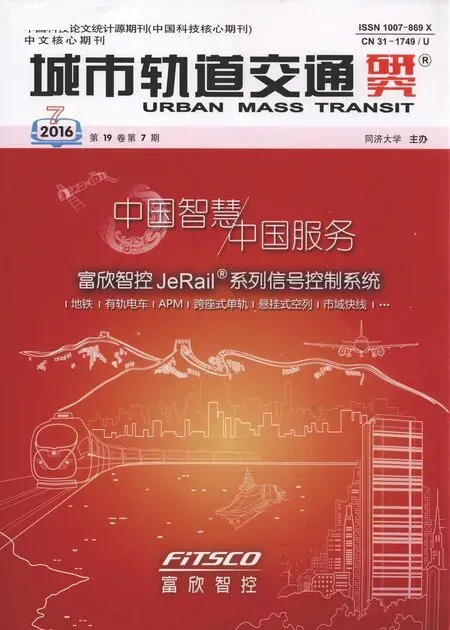广州地铁4号线轨旁ATP故障应对策略研究
杨 柳 唐飞佳
(广州市地下铁道总公司运营事业总部,510030,广州//第一作者,助理工程师)
广州地铁4号线轨旁ATP故障应对策略研究
杨 柳 唐飞佳
(广州市地下铁道总公司运营事业总部,510030,广州//第一作者,助理工程师)
轨旁ATP(列车自动保护)故障后,联锁区内的列车将全部自动紧急制动,列车采用降级模式运行,这会对正常运营产生较大影响。结合广州地铁4号线新造及石碁联锁区轨旁ATP故障实例,对比分析了故障现象及故障影响。阐述了轨旁ATP故障后的应对策略,通过确定关键列车、落实盯控关键列车、实施载客越站方案等策略应对故障,以最大限度降低故障对行车的影响。
广州地铁; 轨旁ATP故障; 应对策略
Author′s address Guangzhou Metro Corporation,510030,Guangzhou,China
广州地铁4号线列车运行高度智能化,如果轨旁ATP(列车自动保护)发生故障,联锁区内的列车将全部自动紧急制动,列车采用降级模式运行,这会对正常运营产生较大影响。考虑到信号设备故障情况下维持降级运营的需要,除了正常连续式列控(CTC)模式外,广州地铁正线信号系统还设计了信号系统故障后的后备模式,包括点式列控(ITC)模式和联锁列控(IXL)模式。
为有效降低轨旁ATP故障对运营造成的晚点压力,对广州地铁4号线轨旁ATP故障情况下的应急策略开展研究。
1 轨旁ATP故障影响分析
表1为广州地铁4号线轨旁ATP故障对比分析表。从表1的事件对比中可以看出:
(1) 两起事件均发生在周末高峰期。在控车方面,石碁联锁区内有13列列车,其中7列列车需重投;新造联锁区内有9列列车,其中6列列车需重投。多列列车以URM(非限制人工驾驶)模式运行,存在一定的安全隐患,需安排人员重点盯控。
(2) 两起事件中列车在站台停车时间均较长。
(3) 在地下区段以URM模式运行,限制速度较低,对延误的影响较大,尤其是以URM模式长距离运行时,延误加深明显。
(4) 大面积信号故障往往伴随叠加故障,在此时,行调在进行全局控制期间,仍要对关键列车进行盯控,防止阻塞后续列车,影响行车效果。
2 轨旁ATP故障初期应对
2.1 轨旁ATP故障现象
当发生轨旁ATP故障时,联锁区域内的列车均降级紧急制动,故障列车司机将故障信息汇报给OCC(运营控制中心),此时,短时间内会有大量电话接入,这会影响行调的故障处理工作,因此,行调需准确判断故障,及时发布全呼指令。
轨旁ATP故障现象如下:
(1) 故障区CTC列车产生紧急制动,出现转RM(限制人工驾驶)提示框,无线定位消失,HMI(人机界面)显示列车占用整个计轴区段(轨道区段显示为红色)。
(2) HMI、LOW(联锁工作站)、CLOW(中央联锁工作站)显示故障联锁区内的信号机灯头打叉消失(现场信号机亮灯)。
(3) LOW、CLOW显示屏蔽门编号(PSDXXX)出现闪烁,屏蔽门图标中间两横变白色,两边两横变红色。
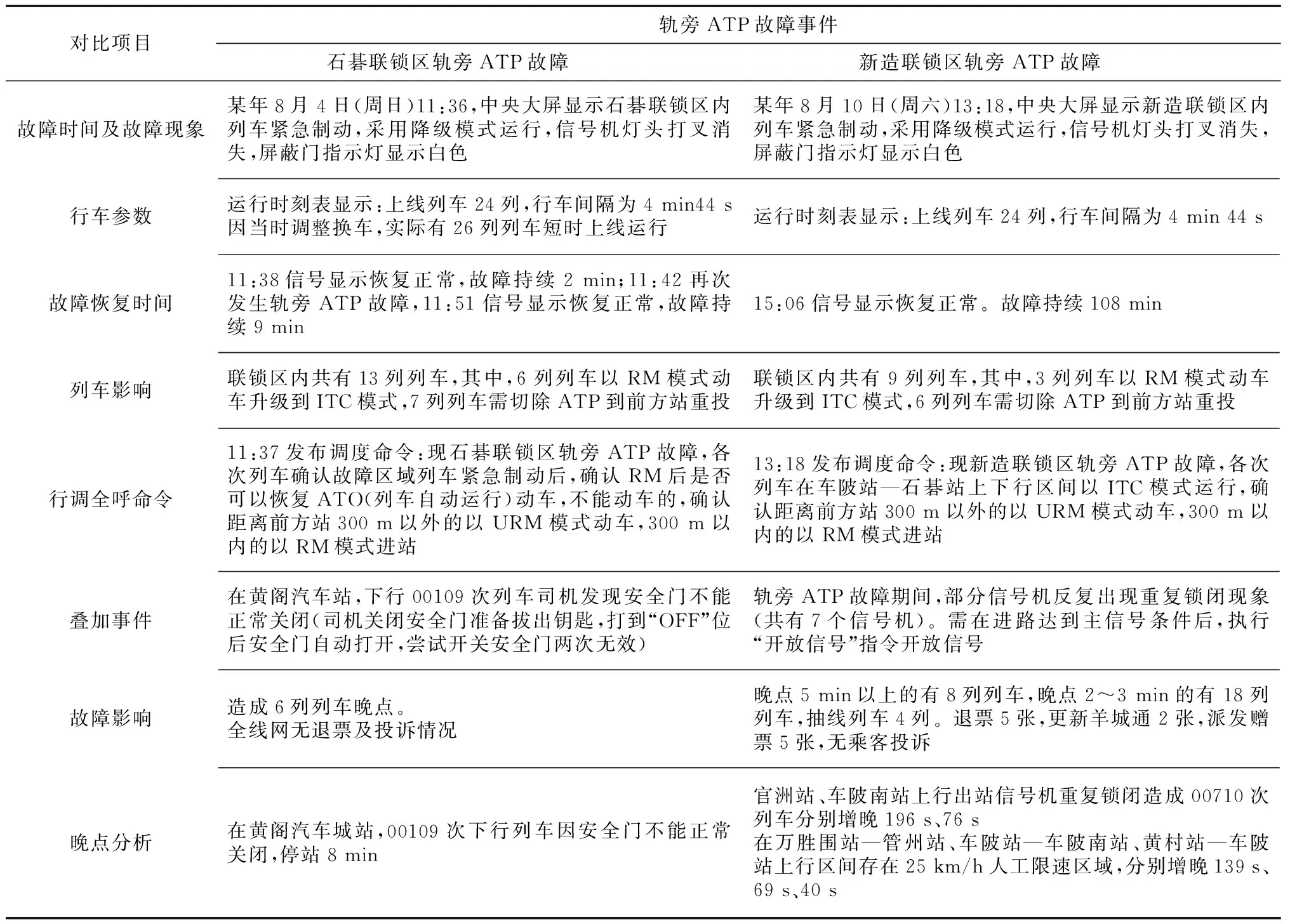
表1 广州地铁4号线轨旁ATP故障对事件比分析
(4) HMI无法监控屏蔽门的开关门状态。
2.2 轨旁ATP故障初期行车命令发布
判断发生轨旁ATP故障后,行调第一时间发布全呼命令,避免大量司机扎堆汇报故障后再抢频发布命令;司机、车站值班员按照行调的行车命令执行,避免长时间停车。如因故联系不上行调,应及时采取措施,可通过车站转达或拨打行调内线电话等方式联系。行调认真核对区域内列车动车情况,对异常列车及时干预。
3 轨旁ATP故障期间应对策略
3.1 关键列车盯控
3.1.1 关键列车的判断
关键列车是指正线最大间隔列车和停站最长时间列车。
在轨旁ATP故障区域,以URM模式运行的列车需到ITC投入站重投。广州地铁4号线ITC投入站示意图如图1所示。由图1可见,广州地铁4号线正线ITC投入站分部不均匀,部分投入站之间间隔较远,其中新造站—大学城南站上行区间紧急列车制动列车需以URM模式运行6个区间才能到到车陂站进行重投。表1中的00710次列车即在该区间紧急制动,以URM模式运行至黄村站退出服务,列车晚点999 s。
广州地铁4号线下行线ITC投入站有8个,上行线只有6个,且上行线中间区域ITC投入站较少,新造联锁区内上行仅新造站为ITC投入站,对距离前方ITC投入站较远的以URM模式运行的列车应做好重点盯控。
以URM模式运行的列车在地下线路与高架线路上运行时的限速要求不同。具体情况见表2、表3和表4。由表中数据可知,URM模式下,列车在地间下区运行时延误程度更深,且地下区段有多个区间存在限速25 km/h运行的区域,这进一步加深了列车晚点的压力。
目前,东涌站—低涌站区间的1902、1901ABC计轴区段已设置信号限速,该区间正常运行时间约为4 min 10 s;非CTC级别下东涌站上行出站信号机(S1907)、低涌站下行出站信号机(X1804)、低涌站至东涌站下行区间信号机(X1901)无法开放。需提前取消信号限速开放绿灯或授权司机越红灯。
综上所述,ITC投入站站间距离及地下线路限速均会对URM模式下列车运行造成较大晚点压力。轨旁ATP故障情况下,新造站、低涌站、黄阁站开出的上行列车,万胜围站、新造站、石碁站开出的下行列车为关键列车。URM模式下长距离限速运行极有可能造成较大延误,阻塞后续ITC列车,并造成大量列车晚点。新造联锁区和石碁联锁区轨旁ATP故障时的重点盯控关键列车见表5。
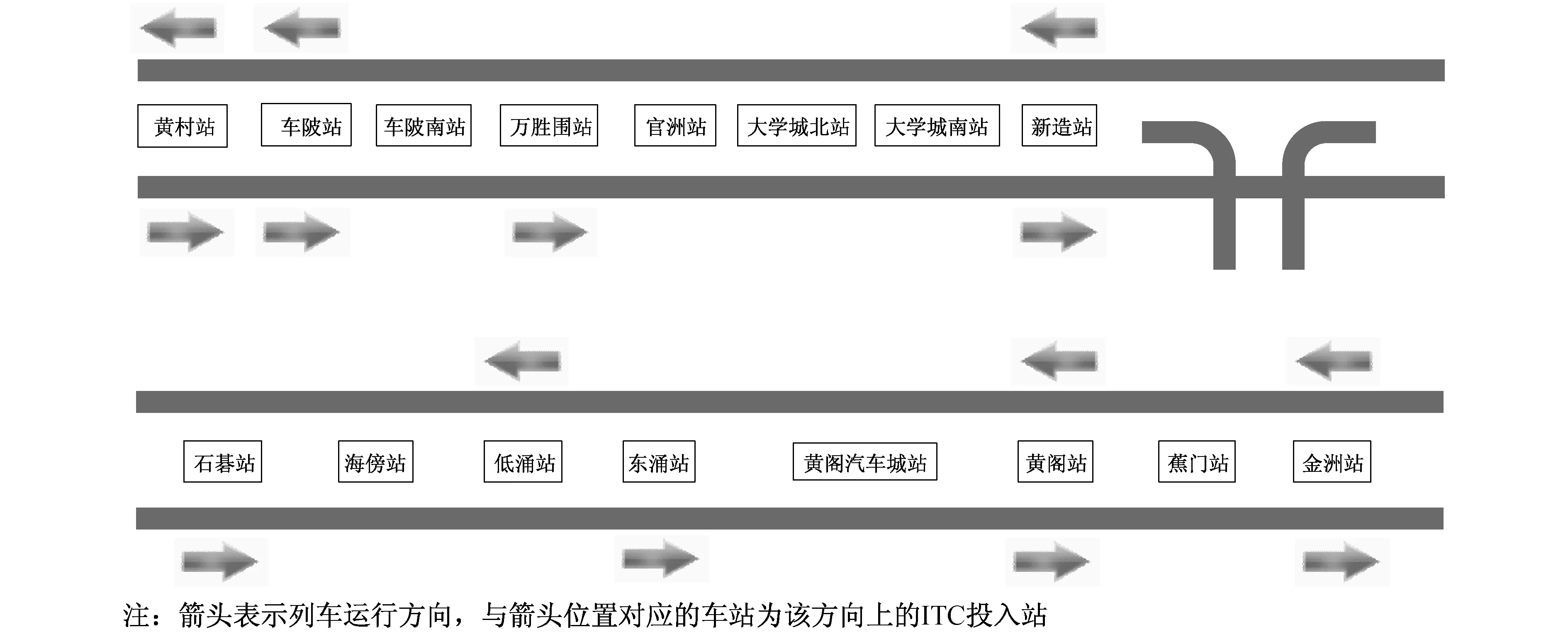
图1 广州地铁4号线正线ITC投入站示意图

区间公里标长度/m下行区间黄村站—车陂站k9+100—k9+800700车陂站—车陂南站k10+700—k11+300600万胜围站—官洲站(*)k17+00—k17+600600石基站—海傍站(*)k33+400—k33+700300上行区间黄村站—车陂站k33+700—k33+400300车陂站—车陂南站k17+600—k17+00600万胜围站—官洲站(*)k11+200—k10+700500石基站—海傍站(*)k9+800—k9+200600

表3 URM模式运行速度要求

表4 电话闭塞法组织行车速度要求
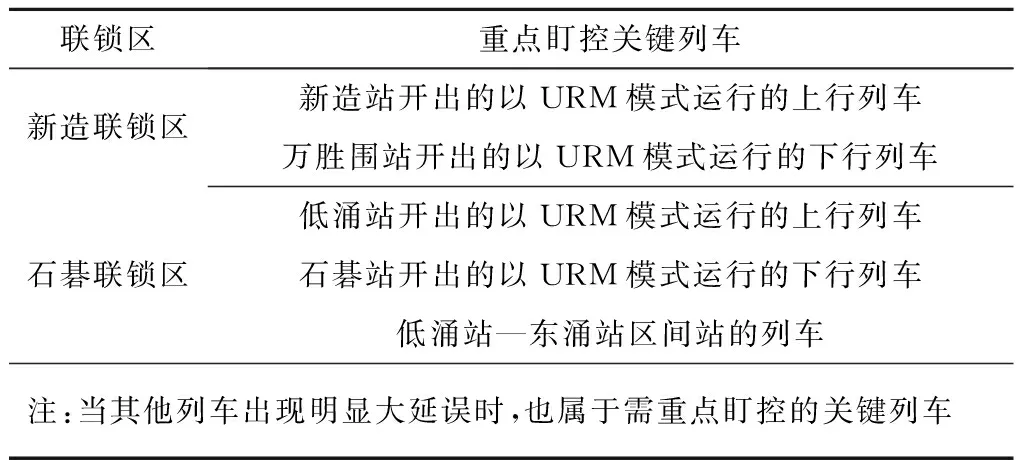
表5 新造联锁区和石碁联锁区轨旁ATP 故障时的重点盯控关键列车
3.1.2 关键列车盯控措施
(1) 专人盯控。控制中心值班主任安排一名行调负责对关键列车进行监控,减少列车在站停站时间。调度部值班人员到达控制室后,协助盯控。
(2) 提前准备进路。关键列车的进路需提前排列,原则上至少提前排列至前方站站台。进路排列完成后,要检查主进路要素是否具备,保证信号均能正常开放主信号。若轨旁ATP故障伴随信号机重复锁闭现象,需将进路取消后重新排列(若列车已到信号机前,则执行“开放信号”组织列车通过后进行重排)。遇信号机不能立即开放情况,及时采取授权越红灯等措施组织列车继续运行。
(3) 当列车在车站开出晚点超过400 s时,调度员电话提醒司机注意后续跟进列车运行情况。
(4) CCTV(闭路电视)监控。盯控行调调整该车停车站台CCTV,监控关键列车站台作业情况。如遇司机在站台作业时间较长时,应及时介入,要求司机关门动车。提前通知车站做好客流组织,避免乘客拥挤阻挡列车车门关闭。
(5) 安排URM监控员。行调在轨旁ATP故障发生后,及时给车站发布全呼命令,车站接受命令后安排人员到站台添乘URM列车,缓解URM列车限速延误压力。URM监控员需经过培训,取得URM列车监控资格。为避免URM列车在站台长时间等待监控员到位,URM列车司机在站台正常作业完毕后立即关门动车,无须等待,按照无URM监控员要求限速运行。对于关键列车的URM监控到位情况,行调及时进行核实,发现无监控员的,至少提前一站通知车站优先安排。
3.2 载客越站措施
当列车产生较大延误,阻塞后续列车运行时,应适当组织载客越站以改善行车组织效率,但是,这也容易造成乘客投诉,甚至有被媒体报道的风险,因此对载客越站措施要充分了解利弊,适当运用。广州地铁4号线2014年各站日均客流量如图2所示。
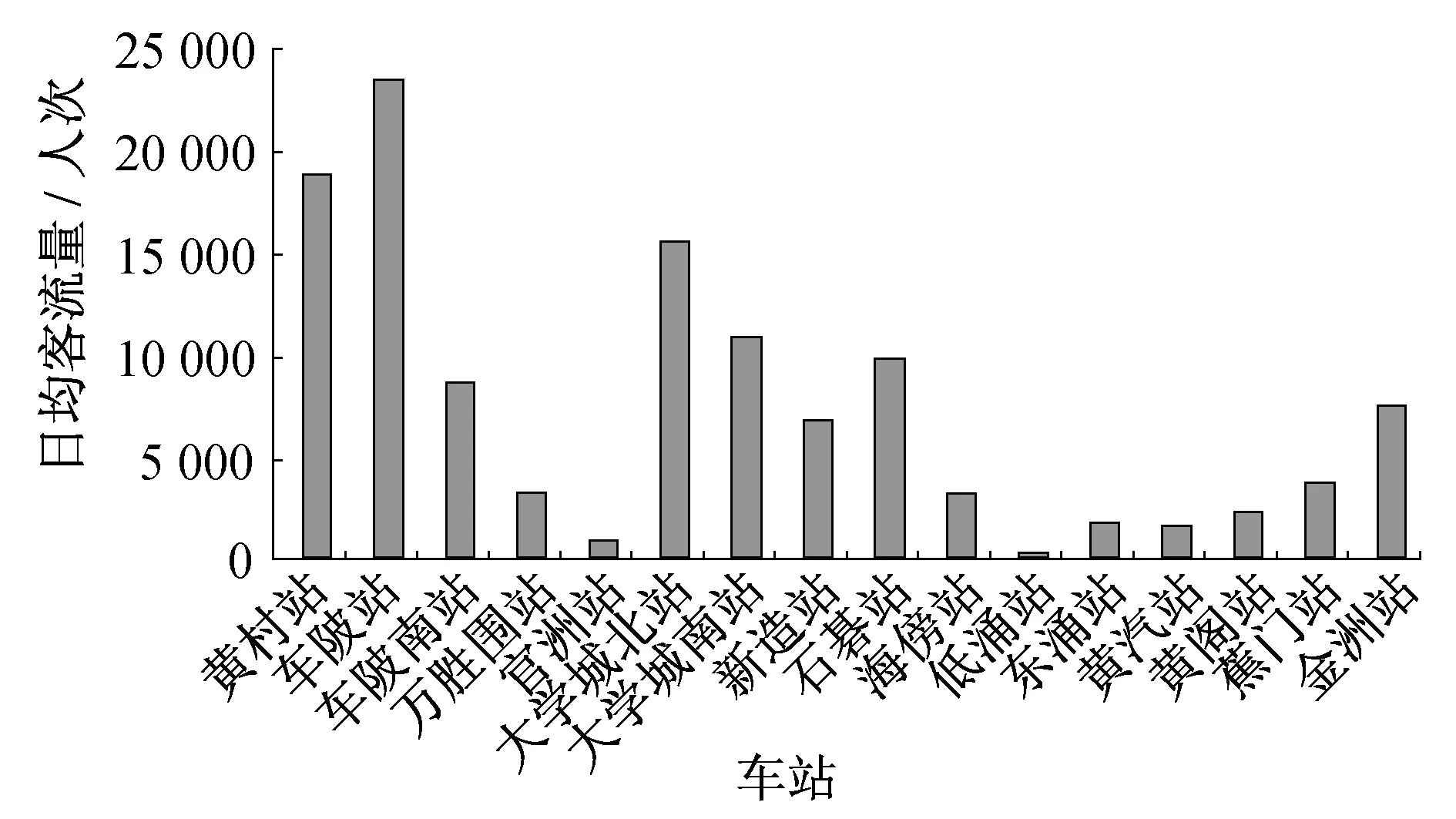
图2 广州地铁4号线2014年各站日均客流量
从客运量考虑,除去换乘站及日均客运量超过5 000人次的车站,还有官洲站、海傍站、低涌站、东涌站、黄汽站、黄阁站和蕉门站7个车站。从周边环境考虑,海傍站周边有亚运城,黄汽站周边有丰田汽车城,蕉门站周边有南沙区政府及公交枢纽,在这些车站载客越站对乘客影响较大。
综上所述,广州地铁4号线应急情况下需组织载客飞站时,应优先选择官洲站、低涌站和黄阁站3个车站,其次再视情况考虑海傍站、东涌站、黄汽站和蕉门站,其余车站不推荐采用载客越站方案。
3.3 驾驶模式转换优化
3.3.1 设备显示正常立即执行“ATP重解”
当信号设备显示恢复正常,车站值班员应立即在LOW上执行“ATP重解”,同时将情况报给行调,无需等待信号人员通知设备恢复。行调监控到设备恢复正常及时提醒车站执行重解命令。
3.3.2 故障区域内预选CTC模式
(1) 轨旁ATP故障区域内紧急制动的列车,以RM模式动车即可,保持预选CTC模式;
(2) 故障区域内紧急制动重投列车,在重投站预选CTC模式;
(3) 进入轨旁ATP故障区域列车,在故障区域前一站预选ITC模式运行,进入故障区域在第一个到达站预选回CTC模式。
(4) 若出现短时两次轨旁ATP故障或其他需ITC维持运营情况,各次列车在故障区域预选ITC模式运行。
4 其他建议
(1) 针对RM模式运行速度过低(18 km/h)的情况,建议地铁公司联合车辆厂家研究列车能否增设RM 25、RM 60档位的工作。
(2) 对于无车载ATP保护的列车,在曲线半径小于400 m的线路上,以限速25 km/h运行的情况进行重新评估,适当提高列车运行速度,减轻列车进一步延误压力。
(3) 当新造联锁区发生轨旁ATP故障时,ITC列车可在车陂站上行线转换CTC模式时机。
目前,新造联锁区轨旁ATP故障后的操作模式是:车陂站至石碁站上下行采用ITC模式运行,故障区域内列车以ITC模式运行至车陂站上行,司机进行开关门操作后才将驾驶模式转换为CTC。黄村站上行列车出清后,黄村站值班员通知车陂站值班员上行ITC列车关门,车陂站上行屏蔽门关好后信号机显示绿灯,此时列车转换模式升级为CTC模式。该做法造成车陂站上行列车等待黄村站列车出清后才能动车,列车在车陂站上行停车时间过长。建议改变现有转换流程,ITC列车到达车陂站上行先操作转换列车模式后再进行其他操作,正常情况下ITC列车到达车陂站上行,预选CTC模式列车立即升级,此时列车关门后即可根据信号动车,省去等待黄村站上行列车出清时间。
[1] 林瑜筠.城市轨道交通信号[M ] .北京:中国铁道出版社,2011:231-232.
[2] 林瑜筠,魏艳,赵炜.城市轨道交通信号基础设备[M].北京:中国铁道出版社,2012:53.
[3] 张学兵,俞太亮.地铁列车运行调整策略选择和制约因素分析[J].现代城市轨道交通,2011(5):70.
(Continued from Special Commentary)
function-synthesis around the rail transit stations induces the regional population and the function distribution along the rail transit lines to turn from dispersion to high density aggregation. Meanwhile,a relatively independent sub-centre of city with distinctive features or a urban complex will be induced to form at the integrated transport hubs and important station areas,presenting a new type of urban agglomerations with multi-center and multi-core.Thirdly,the development trend of the rail transit integration of urban agglomerations has been presented.Namely,the urban transit highly merges together with the intercity transit and the trans-regional long-distance transit.The urban transport not only relies on metros,light rails and buses,but also highly depends on various transport modes,such as intercity railways,regional railways and suburban railways etc.The transport of urban center areas is dominated by metro.Passage clear and linkages within the urban agglomerations more rely on the intercity railways and the suburban railways that operate just like city buses.
Being acutely aware of the profound changes in urban development could help us to do the rail transit construction and the operation management work more actively and promisingly.Firstly,the objective laws of urban development should be earnestly followed.Those advanced concepts must firmly be established,such as,“constructing a metro is just constructing a city”,“metro construction′s leading urban development”and etc.,realizing the conceptual change of urban rail transit from pure transport services to supporting the urban development and enhancing the rail transportation practitioners′ initiative,the sense of duty and bearing responsibility.Secondly,the strength of the metro superstructure property development should be increased.Accurately grasp the relationship between the urbanization and the rail transportation integration of urban agglomerations.Around the sites and the axial lines of rail stations,the high-strength development with both compact and focus should be implemented.Guide industries,population and services to gather toward rail transit station sites,promote regional contact and industry upgrade,and lift the value and quality of the land around the rail transit station fields,making it become the main axial line and important stronghold of the regional development of economy and society.Thirdly,explore the sustainable development mode of “rail + property”.The property development around the metro station fields and along the metro lines should be implemented with rail transit enterprises as leading.Internalize the metro property development earnings and the commercial added-value formed directly because of metro′s opening into the rail transit enterprises′ income,making the metro enterprises turn from previously depending on blood-transfusion in finance into a self blood-making mechanism in finance.Those acquired property development profits could be used for compensating the capital lack in metro constructions and the metro-operating losses,constructing the sustainable development mode of “rail + property” of metro enterprises.Fourthly,the top layer design of the rail transit integration development of urban agglomerations must be done well.The high-level leadership mechanism and the coordination and communication mechanisms should be established within the urban agglomerations.Formulate the rail transit integration development strategy and the implementation plan.Make clear the construction objectives,the duty segregation and the safeguard measures.Fifthly,carry out the all-round cooperation of urban rail transportation integration development.Do well each city′s overall planning in advance.Make definite the lines′ docking mode and the station sites′ docking mode between cities.According to the industry characteristics of different cities,carry out differentiation and development of regional economy.Coordinate the implementation of rail transit projects.Adopt the PPP (Public-Private Partnership) mode to attract social capital to participate in the rail transit construction and operation management.
It could be expected that China′s urban agglomeration led by the rail transportation integration development will be an engine to drive future economic growth.Relying on the “rail + property ” mode will be more conducive to seize the commanding heights of development pattern of urban agglomerations in China.
(Translated by SUN Zheng)
Coping Strategies against Track Side ATP Fault on Guangzhou Metro Line 4
YANG Liu,TANG Feijia
When a track side ATP fault happens, all the trains in the interlocking area will take emergency breaking and run in degraded mode, that greatly threatens the normal operation. Based on the track side ATP fault on Guangzhou metro Line 4, the fault phenomenon and effects are comparatively analyzed. Then, the coping strategies against track side ATP fault are described, including traffic organization control link, skip schem and so on,to minimize the impact of track side ATP fault on train operation.
Guangzhou metro; track side automatic train protection (ATP) fault; coping strategy
U 231.6
10.16037/j.1007-869x.2016.07.034
2015-04-07)

